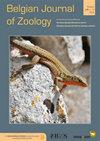加勒比珊瑚礁中灰鼻龙(Cuvier,1830)发声和相关咽颚的特征
IF 1.1
4区 生物学
Q2 ZOOLOGY
引用次数: 2
摘要
产生声音进行声学交流的能力在不同的呼噜虫物种中是众所周知的(血蛛科)。然而,大多数声音都没有被描述,很少有呼噜声物种的声音产生机制已经被深入研究。需要更多的数据来寻找声音机制中的突触形态。本研究描述了金血龙的声学特征和鳃的解剖结构。在一些声学特征和标准长度之间发现了相关性,表明最大的样本产生了更短、音调更低、强度更高的呼噜声。对声学特征和鳃解剖的检查表明,H.aurolineatum使用了与之前在H.flavolineatum中描述的相同的发声机制。Haemolon物种的不寻常特征涉及第四角鳃。这些似乎是下咽颚的一部分,因为它们有牢固附着的牙齿,面向上咽颚。摩擦咽和第四角支的牙齿会产生刺耳的声音。这一机制可能在23种嗜血杆菌属物种中很常见,但还需要更多关于其他嗜血杆菌科物种产生刺耳声音的机制的信息。第四角分支可能是血菌科产生声音的能力的关键因素,为家族机制提供了最终的突触形态方面。本文章由计算机程序翻译,如有差异,请以英文原文为准。
Characteristics of sound production and associated pharyngeal jaws in the tomtate grunt Haemulon aurolineatum (Cuvier, 1830) in Caribbean reefs
The ability to produce sounds for acoustic communication is well known in different grunt species (Haemulidae). However, most of the sounds have not been described and the sound-producing mechanism of very few grunt species has been deeply studied. Additional data is needed to search for synapomorphy in the sonic mechanism. This study describes acoustic features and branchial anatomy in Haemulon aurolineatum . Correlations were found between some acoustic features and standard length, showing the largest specimens produced shorter, lower-pitched grunts of higher intensity. Examinations of acoustic features and branchial anatomy show that H. aurolineatum uses the same stridulatory mechanism described previously in H. flavolineatum . The unusual feature of Haemulon species concerns the fourth ceratobranchials. These appear to be part of the lower pharyngeal jaws since they possess firmly attached teeth that face the upper pharyngeal jaws. The stridulation results from the rubbing of both pharyngeal and fourth ceratobranchial teeth. This mechanism is probably common to the 23 Haemulon species, but additional information is needed regarding the mechanism of other Haemulinae species to produce stridulatory sounds. Fourth ceratobranchials could constitute a key element of Haemulinae ability to produce sounds providing an eventual synapomorphic aspect of the mechanism in the family.
求助全文
通过发布文献求助,成功后即可免费获取论文全文。
去求助
来源期刊

Belgian Journal of Zoology
生物-动物学
CiteScore
1.90
自引率
0.00%
发文量
10
审稿时长
>12 weeks
期刊介绍:
The Belgian Journal of Zoology is an open access journal publishing high-quality research papers in English that are original, of broad interest and hypothesis-driven. Manuscripts on all aspects of zoology are considered, including anatomy, behaviour, developmental biology, ecology, evolution, genetics, genomics and physiology. Manuscripts on veterinary topics are outside of the journal’s scope. The Belgian Journal of Zoology also welcomes reviews, especially from complex or poorly understood research fields in zoology. The Belgian Journal of Zoology does no longer publish purely taxonomic papers. Surveys and reports on novel or invasive animal species for Belgium are considered only if sufficient new biological or biogeographic information is included.
 求助内容:
求助内容: 应助结果提醒方式:
应助结果提醒方式:


